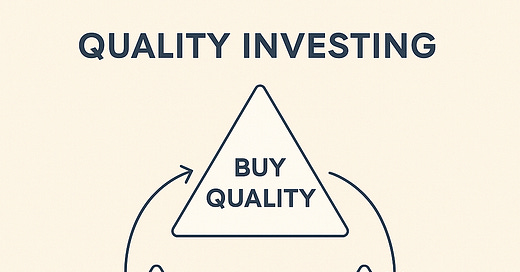🏆 Quality Investing: A Simple, Powerful Strategy
There are many ways to gain an edge in investing. But the simplest—and the one that makes the most conceptual sense to me—is this:
Invest in High-Quality Companies.
Buy them at a Fair (or better) Price.
Wait.
Get step one right, and you're already on the path to above-average returns. Add step two, and you're compounding your advantage. But step three is non-negotiable. Patience is what unlocks the magic of compounding and takes your portfolio to the next level.
I've written extensively about this approach, so I won't rehash the core concepts here. If you're looking for a deeper dive into Quality Investing and how to add some "icing on the cake," check out.
Quality Investing and some Icing on the Cake.
💳 A Real Example: Mastercard
Let’s take Mastercard MA 0.00%↑ —an exceptional business with a strong track record of both quality and growth.
Just look at the numbers.
Compare the 3-year and 10-year growth figures, and you'll see no signs of slowing down. Mastercard is a textbook example of a quality company—one that has consistently delivered above-average returns, regardless of whether it was undervalued at the time of purchase.
📊 Time in the Market Beats Timing the Market
Let’s look at Mastercard’s performance over the last seven years (1,763 trading days since May 3, 2018):
Average CAGR: 17.23%
Worst-case CAGR: -1.58%
Best-case CAGR: 34.62%
The best day to have invested was October 27, 2023. The worst? February 28, 2025. Yet, even with that spread, only 4 out of 1,763 days led to a negative return. That’s just 0.23% of the time.
🎯 Odds of hitting these return thresholds:
10%+ return: 93.98%
12%+ return: 87.46%
15%+ return: 60.58%
20%+ return: 28.98%
25%+ return: 10.72%
30%+ return: 1.3%
✅ You had a better chance of earning a 30% return than losing money.
If we remove the last year (to strip out recent volatility) and focus only on holding periods longer than a year, the odds of a 10%+ return rise to 99.93%. You’d have to be extraordinarily unlucky to walk away with anything less.
💰 Valuation: A Tool, Not a Rule
Using my Free Cash Flow (FCF) model, Mastercard appeared, on average, 4.9% overvalued over the 7-year period. The extremes ranged from 44.99% overvalued to 36.78% undervalued.
Here’s a visual.
And here’s a visual of the annualized returns.
Still, most days—even the overvalued ones—delivered market-beating returns. The undervalued periods (especially from 2022 onward) delivered even better results. For instance, an investment made in early 2022 now shows a 15% CAGR, even though it spent the first 15 months underwater.
This reinforces an essential truth: You don’t make money by buying a stock. You make money by holding it.
📉 The Power of Compounding
Looking only at the days Mastercard appeared undervalued, the average CAGR was 19.94%. On overvalued days, it was 14.77%. Exclude the last 12 months, and the undervalued CAGR jumps to 22.98%, while the overvalued one remains unchanged.
Here’s a total return chart to help you better visualize to impact of compounding.
🧠 Opportunity Cost Matters
Your primary focus should be identifying high-quality companies with consistent growth. Valuation helps, but it's secondary to the opportunity cost of where else your capital could be working.
Had I limited myself to buying Mastercard only when it was fairly valued, I would have missed out on substantial returns—even when it looked expensive. Fortunately, we don’t have to pick just one stock. But capital allocation always comes back to expected future return.
As of today, my model shows:
Mastercard: 3% undervalued, 15.3% expected long-term CAGR
UnitedHealth Group: 24% undervalued, 13.8% expected CAGR
Despite being more undervalued, UnitedHealth doesn’t quite edge out Mastercard in terms of projected return.
✅ Quality at a Fair Price
The goal of my investment strategy—and this newsletter—is simple:
Identify quality companies, calculate a fair value, and estimate long-term return potential.
This approach resonates with me because it’s rational, repeatable, and has a strong track record of delivering results.
If you'd like access to my full list of Quality Stocks and their return projections, consider upgrading to a paid subscription.







Where can I find this full list?